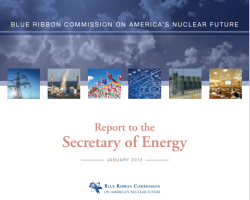Category of Content
Siting Experience Documents Only
Publication Date
Country
Keywords
An Approach for Validating Actinide and Fission Product Burnup Credit Criticality Safety Analyses--Isotopic Composition Predictions
An Approach for Validating Actinide and Fission Product Burnup Credit Criticality Safety Analyses--Isotopic Composition Predictions
Taking credit for the reduced reactivity of spent nuclear fuel in criticality analyses is referred to
as burnup credit. Criticality safety evaluations employing burnup credit require validation of the
depletion and criticality calculation methods and computer codes with available measurement
data. To address the issues of burnup credit criticality validation, the U.S. Nuclear Regulatory
Commission initiated a project with Oak Ridge National Laboratory to (1) develop and establish
Sensitivity Coefficient Generation for a Burnup Credit Cask Model Using TSUNAMI-3D
Sensitivity Coefficient Generation for a Burnup Credit Cask Model Using TSUNAMI-3D
Sensitivity and Uncertainty Analysis of Commercial Reactor Criticals for Burnup Credit
Sensitivity and Uncertainty Analysis of Commercial Reactor Criticals for Burnup Credit
This paper provides insights into the neutronic similarities between a representative high-capacity rail-transport cask containing typical pressurized water reactor (PWR) spent nuclear fuel assemblies and critical reactor state-points, referred to as commercial reactor critical (CRC) state-points. Forty CRC state-points from five PWRs were analyzed, and the characteristics of CRC state-points that may be applicable for validation of burnup-credit criticality safety calculations for spent fuel transport/storage/disposal systems were identified.
Legal Analysis of Commission Recommendations for Near-Term Actions
Legal Analysis of Commission Recommendations for Near-Term Actions
At the request of the staff to the Blue Ribbon Commission on America’s Nuclear Future (“BRC”), we have reviewed whether certain recommendations in the BRC’s July 29, 2011 Draft Report respecting near-term actions by the Department of Energy (“DOE”) or other officers or agencies in the Executive Branch can be implemented under existing law. These recommendations relate to:
(1) Initial steps to site, license and construct consolidated interim storage facilities for spent nuclear fuel (“spent fuel”);
THE ROLE OF INDIAN TRIBES IN AMERICA’S NUCLEAR FUTURE
THE ROLE OF INDIAN TRIBES IN AMERICA’S NUCLEAR FUTURE
Indian tribes have voiced their tribal issues in the United States‘ nuclear effort since its
inception, with the siting of what would become Los Alamos National Laboratory adjacent to the
San Ildefonso Pueblo Reservation and the Hanford plutonium production works along waterways
shared with the Yakama Nation and other Indian tribes. The siting of a proposed repository at
Yucca Mountain, Nevada along with other activities conducted on the Nevada National Security
Site (NNSS) (formerly the Nevada Test Site), increased the need for the United States
Sensitivity and Uncertainty Analysis of Commercial Reactor Criticals for Burnup Credit
Sensitivity and Uncertainty Analysis of Commercial Reactor Criticals for Burnup Credit
The purpose of this study is to provide insights into the neutronic similarities that may exist between a
generic cask containing typical spent nuclear fuel assemblies and commercial reactor critical (CRC) state-
points. Forty CRC state-points from five pressurized-water reactors were selected for the study and the
type of CRC state-points that may be applicable for validation of burnup credit criticality safety
calculations for spent fuel transport/storage/disposal systems are identified. The study employed cross-
Sensitivity and Parametric Evaluations of Significant Aspects of Burnup Credit for PWR Spent Fuel Packages
Sensitivity and Parametric Evaluations of Significant Aspects of Burnup Credit for PWR Spent Fuel Packages
Spent fuel transportation and storage cask designs based on a burnup credit approach must
consider issues that are not relevant in casks designed under a fresh-fuel loading assumption. For
example, the spent fuel composition must be adequately characterized and the criticality analysis
model can be complicated by the need to consider axial burnup variations. Parametric analyses are
needed to characterize the importance of fuel assembly and fuel cycle parameters on spent fuel
An Approach for Validating Actinide and Fission Product Burnup Credit Criticality Safety Analyses-Criticality (keff) Predictions
An Approach for Validating Actinide and Fission Product Burnup Credit Criticality Safety Analyses-Criticality (keff) Predictions
Taking credit for the reduced reactivity of spent nuclear fuel (SNF) in criticality analyses is referred to as burnup credit (BUC). Criticality safety evaluations require validation of the computational methods with critical experiments that are as similar as possible to the safety analysis models, and for which the keff values are known. This poses a challenge for validation of BUC criticality analyses, as critical experiments with actinide and fission product (FP)
Deciding for the Future: Balancing Risks, Costs, and Benefits, Fairly Across Generations
Deciding for the Future: Balancing Risks, Costs, and Benefits, Fairly Across Generations
The key challenge of this National Academy of Public Administration project is captured in the subtitle of this report, Balancing Risks, Costs, and Benefits Fairly Across Generations.
Blue Ribbon Commission on America’s Nuclear Future Report to the Secretary of Energy
Blue Ribbon Commission on America’s Nuclear Future Report to the Secretary of Energy
This report highlights the findings and conclusions of the Blue Ribbon Commission on America’s Nuclear Future (BRC) and presents recommendations for consideration by the Administration and Congress, as well as interested state, tribal and local governments, other stakeholders, and the public.
Enhancing the Role of State and Local Governments in America's Nuclear Future: An Idea Whose Time Has Come
Enhancing the Role of State and Local Governments in America's Nuclear Future: An Idea Whose Time Has Come
The Blue Ribbon Commission on America's Nuclear Future was formed by the Secretary of<br/>Energy at the direction of the President. The Commission was formed to conduct a<br/>comprehensive review of policies for managing the back end of the nuclear fuel cycle, including<br/>all alternatives for the storage, processing, and disposal of civilian and defense used nuclear fuel,<br/>high–level waste, and materials derived from nuclear activities.


